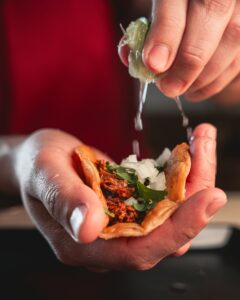Dia de los Muertos, the Mexican celebration when the dead are believed to come back for a visit, is marked with ofrenda altars, traditional music, folkloric dance, and a ceremonial roll call of departed loved ones.
Coming on the heels of Halloween and All Saints Day, the Day of the Dead will be celebrated at Mexican restaurants and taquerias across Alabama.
Birmingham’s 22nd Dia de los Muertos festival is set for Saturday, November 2, starting at 3 p.m. at Sloss Furnaces. Advance tickets are $15 for ages 12 and up and $20 at the gate. Montevallo’s 2nd Annual Dia de los Muertos Festival is also November 2, from 2 p.m. to 10 p.m. Admission is free to the event at 620 Valley Street in Montevallo.
Wherever you celebrate, you’ll find delicious street snacks like tacos, burritos, gorditas, sopes, and torta sandwiches, with a variety of fillings listed on menus.
Mexican street food is the ultimate in tail-to-snout cooking, turning parts many would throw away into delicious, craveable dishes. But the sparse translations on menu boards for fillings like carnitas, chorizo, cueritos, and asada are not always helpful or illuminating.
Don’t worry. Here is a guide to guisados (stewed dishes) and roasted meats made from pork or beef that are commonly served in tacos and other snacks.

(Adios/Facebook)
Pork
Al pastor – Mexico’s version of Middle Eastern shawarma, it starts by marinating thinly sliced pork in vinegar, chiles, garlic, pineapple, oregano, and other spices. The meat is then stacked on a spit called a trompo and topped with a pineapple. The spit slowly turns in front of a heat source, and cooked meat is sliced off like shawarma (Lebanese immigrants to Mexico introduced their lamb version of shawarma starting in the late 19th century).
Carnitas —Think of it as a Mexican take on pulled pork, only instead of being barbecued, fattier cuts like shoulder are marinated, slowly simmered for hours, and finished, confit-style, in lard. Once the flavorful meat is shredded, some pieces are crisp while others are tender and moist.
Chorizo – The sausage is made with garlic, chiles, and vinegar. This is a fresh sausage, unlike its dry-cured sibling from Spain or its Portuguese cousin, linguica. Another Mexican sausage sometimes found at taquerias and trucks is longaniza, which is less spicy than chorizo and is flavored with garlic, paprika, cinnamon, and anise seed.
Buche – Pork stomach is thoroughly cleaned, chopped, and simmered for hours in onion, garlic, seasonings, and chiles. It’s finished by crisping on a griddle, which provides buche’s signature crunch. The result is porky, with only a mild organ flavor.
Cueritos – They are made from pork skins, only instead of being deep-fried like chicharrónes, cueritos are slowly simmered until lip-stickingly gelatinous and powerfully flavorful. Often they are cooked with carnitas.
Oreja – Not common around here, they are slow-cooked pig ears. Parts have a soft texture, while the cartilage provides crunch.
Beef
Asada – Also known as carne asada, it is traditionally made from cuts including skirt, flap, or flank, which are very flavorful but require marination to help tenderize them. Asada is Spanish for roasted or grilled, so the name indicates the cooking technique and not a specific recipe. Once soaked in oil, lime, herbs and spices, chile peppers, and garlic, the meat is quickly cooked over fire and thinly sliced against the grain.
Campechana – This is a combination of asada and sausage, usually chorizo.

(Adios/Facebook)
Suadero – Traditionally made with belly meat but more commonly with brisket, the meat is cooked like carnitas—slowly rendered, confit-style, in water and fat. Often taqueros cook suadero, sausage, and tripe together, with each contributing its own flavors.
Cabeza – The genius of taco-makers is their ability to turn throw-away portions of an animal into something deliciously desirable. Cow heads are a prime example. When slowly grilled, roasted, or steamed, picked head meat is the source of cabeza as well as other distinct taco fillings. Tongue (lengua) and cheek meat (cachete) are the most generally popular; sometimes you’ll also find brain (sesos). Lengua has a spongy texture and mild beefy flavor. Cachete is a fatty flavor bomb. Sesos is said to have a very soft, custard-like texture.
Tripas – Tripe made from a cow’s small intestine is another ultimate example of whole-animal cooking. They are thoroughly cleaned and simmered in water until soft, then chopped and fried crisp in oil.




